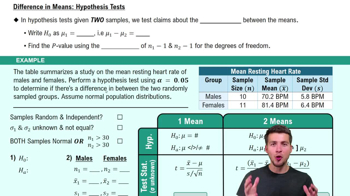Here are the essential concepts you must grasp in order to answer the question correctly.
Scientific Notation
Scientific notation is a way of expressing numbers that are too large or too small to be conveniently written in decimal form. It is typically used in scientific and engineering contexts. A number is expressed in the form of a × 10^n, where 1 ≤ a < 10 and n is an integer. For example, 1.23E5 represents 123,000.
Recommended video:
Difference in Means: Hypothesis Tests
Exponentiation
Exponentiation is a mathematical operation involving two numbers, the base and the exponent. The operation is written as b^n, where b is the base and n is the exponent, meaning b is multiplied by itself n times. For example, (0.2)^12 means multiplying 0.2 by itself 12 times, which is crucial for solving the given expression.
Converting Scientific Notation to Decimal
Converting scientific notation to a decimal involves moving the decimal point to the right for positive exponents or to the left for negative exponents, based on the power of ten. For instance, 1.23E-4 is converted to 0.000123 by moving the decimal point four places to the left, which is essential for expressing results in ordinary numbers.
Recommended video:
Difference in Means: Hypothesis Tests




